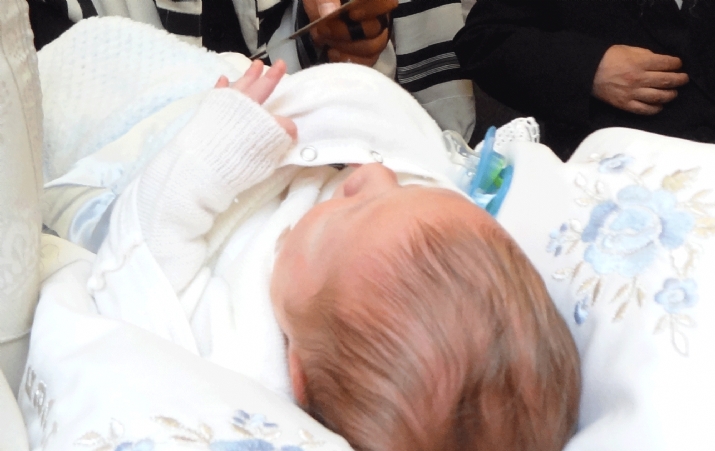Insights
Question:
What is the significance of a shalom zochor and the minhagim that are associated with it?
Insight:
A shalom zochor is a custom performed on Friday night before a newborn male child reaches the eighth day of his life, the day that he is to have a bris milah. It isn’t necessarily a meal, but a festive gathering that includes the minhag of eating chick peas. This custom reflects the fact that although everyone is ecstatic over the birth of the child, there exists a sense of mourning, as well. While the child was present within his mother as a fetus, he was learning Torah with a malach. Upon being born and entering the realm we call olam hazeh, the malach touches him above his mouth and he forgets his learning. Thus, there is a sense of sadness that permeates the gathering, and we therefore eat arbis, a round food that conveys a state of mourning, similar to the round bagels eaten in the house of a mourner.
We will first discuss the meaning of the shalom zochor, which occurs specifically on Shabbos, and then, next week, continue with the child forgetting his learning.
The Torah requires an animal to be eight days old before it is permissible to be used as a korban. Something that is only seven days old, the days of teva, has not entered the realm of eight to be used for avodas Hashem. There are two distinct systems that exist in our world. One functions naturally and openly. That is teva, which is represented by the seven days of the week and reflects the physical world of olam hazeh. The realm of eight represents that which is beyond teva and refers to the world of Olam Haba with its sense of kedushah that is hidden within the world of teva. Thus, only something that has in some sense connected with the world of eight through reaching his eighth day milestone could be used for a korban. For now it could serve as a keili, vessel, to reveal the kedushah that is hidden in our world.
The absolute sense of kedushah is represented in eight, but there is a mei’ein, a glimmer of that world, that is present in our world of teva as well.
Hashem created the physical world in seven days and “rested” on the seventh. The concept is that our world is not to be simply looked upon as existing as the seven days of creation, but, rather, that there are six days of physical creation, with the seventh day considered part of the physical world of teva, but reflecting the glimmer of the absolute realm of kedushah of Olam Haba. It serves to represent menucha, a sense of rest that occurs as a form of completion, when all the physical work is completed and the goal has been reached. The tachlis of olam hazeh is to lead to our existence in Olam Haba as a function of our earning it through our learning of Torah and performance of mitzvos while in this world. Thus, the seventh day of Shabbos represents the glimmer in our world of Olam Haba and is thus a requirement for the newborn child to experience before he receives his bris milah.
Just as the animal enters his capacity to be utilized for avodas Hashem when he becomes eight days old, so does the young child enter his world of avodah through bris milah on the eighth day of his life. This mitzvah establishes the child as existing for the realm of Olam Haba, and thus it must first be prefaced by the seventh day of Shabbos. In order for the child to be able to relate to the absolute realm of eight, his neshamah must first be “to’em,” or taste, the “mei’ein” of the world of eight in the seventh day of Shabbos. Chazal refer to this as to first experience the “matronisa,” the princess, before we can enter the realm of eight. It is this idea that reflects the awesome kedushah of the seventh day of Shabbos. This idea can be seen with regard to the specific day Matan Torah occurred.
The Gemara discusses what specific day of the month of Sivan Hashem bestowed His Torah upon Klal Yisroel. Although there is a dispute about what day of the month it occurred, all agree that it occurred on Shabbos. Shabbos represents the capacity for our physical world to relate to kedushah. As such, it had to be the day when the ultimate dimension of spirituality, Torah, came to the world. Shabbos could be considered the ultimate host for all the specific kedushah that is to be represented. Thus, when a Yom Tov occurs on Shabbos, the specific tefillos of Yom Tov become dominant, with the day of Shabbos merely being referenced in some added words. For this is kedushas Shabbos, serving as the conduit of kedushah in our world. Therefore, a shalom zochor is celebrated on Shabbos, for through that holy day, all, including the young newborn, are able to relate to the hidden kedushah that is represented in Olam Haba.
• • • • •
“Insights” deals with questions on Torah, mitzvos and inyonei machshavah. Questions to be addressed may be sent to Yated Ne’eman, 53 Olympia Lane, Monsey, New York, 10952-2829, or emailed to ahronrapps@yeshivanet.com or editor@yated.com.








